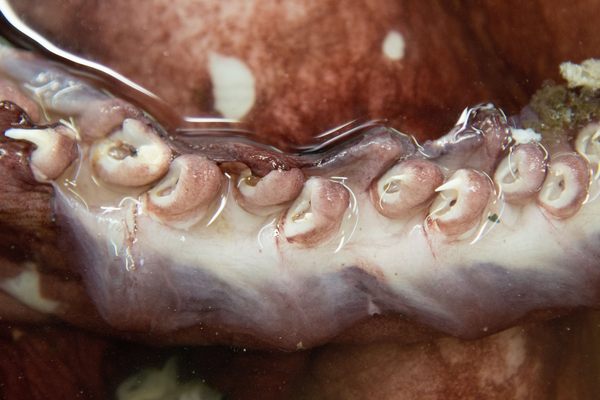Rediscovering the Forgotten Whales of the Mediterranean Sea
Researchers uncovered evidence of the cetaceans at sites connected to the Roman fish-processing industry.

About two millennia ago, Pliny the Elder described a dramatic sight. In the Bay of Cádiz, on the west coast of Spain, just beyond the Strait of Gibraltar, where the Atlantic Ocean and the Mediterranean Sea meet, killer whales would attack the young calves of other whales, small and vulnerable. Pliny was one of Rome’s preeminent natural historians, but he can’t be entirely trusted—he also wrote about unicorns as if they were real. And the scene he describes would never happen today: Few whales visit this part of the world. For centuries, his description was not taken as fact. Perhaps he was thinking of dolphins.
But according to new research, Pliny’s description may have been correct—there’s evidence that at least two species of whales that spend time near the coast once traveled to the Mediterranean area as part of their yearly migrations.
Evidence of the existence of these whales is scarce, as a team of researchers writes in a new paper in the Proceedings of the Royal Society B. “Whale bones seldom make it to human settlements,” they write. “Most whales die and sink in the sea; and those that make it to the shore typically have their skeletons broken down and dispersed by the action of the waves.” When humans have kept the bones of whales that they’ve caught or found, they often break or carve those bones into smaller pieces, making them hard to identify.
But in the new paper, the researchers use two techniques—DNA analysis and collagen fingerprinting—to analyze ancient bone fragments, found in Roman era settlements near Gibraltar, that might have come from whales. Of the 11 specimens they analyzed, nine did indeed come from whales. The team identified six of those as species that are no longer found anywhere near the Mediterranean.
Three of the fragments, the team reports, came from North Atlantic right whales, which now live only much further north, in a threatened population. Three other fragments came from gray whales, now found only in the North Pacific.

While the whales that live in this region today are large and live out in the deep waters, North Atlantic right whales and gray whales come close to the coast while they’re migrating to calving grounds. Thousands of years ago, naturalists like Pliny would have been able to catch sight of them. And, the researchers write, it’s possible that Roman society had an active practice of catching the whales for their meat and blubber.
The bone fragments they analyzed came from archaeological sites connected to the Roman fish-processing industry, where huge salting tanks have been discovered. Gibraltar was a fishing and processing hub, where the Roman condiment garum, a fish sauce, would have been made. Whether the whales beached on shore or were actively hunted, archaeologists and historians knew how they might have been used.
The researchers found another intriguing bit of the past, too, in their analysis. One of the other bone fragments came from a dolphin. But the last came from a North African elephant subspecies, the type used by Carthage in the Punic Wars, now extinct. What it was doing in Spain isn’t clear.
Knowing that these particular whales once lived in the Mediterranean is a clue to grasping how much the world has changed over the past couple thousand years, through the influence of humans. Why don’t these species live in the Mediterranean any more? Hunting pressure has changed the ecology of the oceans so dramatically that no one quite believed that coastal whales ever lived in this area. As the researchers write, “understanding the full extent to which humans have modified natural ecosystems is not straightforward, because we have been doing so for millennia, and then forgetting about it.”

























Follow us on Twitter to get the latest on the world's hidden wonders.
Like us on Facebook to get the latest on the world's hidden wonders.
Follow us on Twitter Like us on Facebook